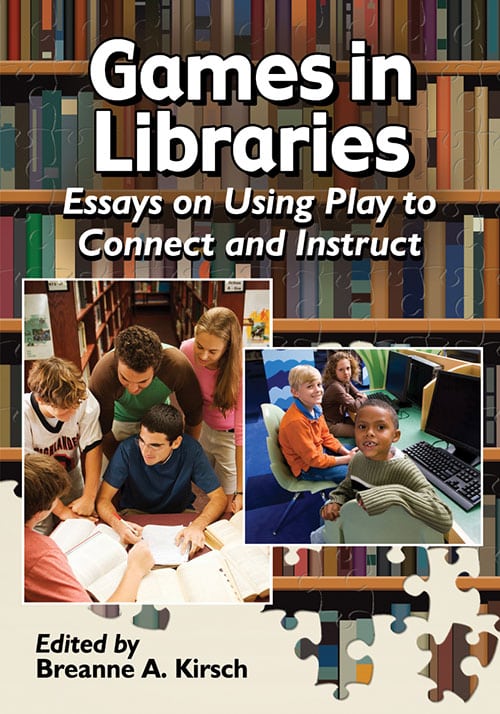 Review Fix chats with Breanne A. Kirsch, author of Games in Libraries: Essays on Using Play to Connect and Instruct, who lets us know what inspired the book and what the future holds for her.
Review Fix chats with Breanne A. Kirsch, author of Games in Libraries: Essays on Using Play to Connect and Instruct, who lets us know what inspired the book and what the future holds for her.
Review Fix: What inspired this book?
Breanne A. Kirsch: After attending a variety of library conferences, I kept learning about new ways librarians were using games in their libraries and institutions. I felt that these ideas should be shared with a wider audience than the local conferences where I was hearing about them. So I thought of creating an edited book incorporating a new author for each of the ideas I had heard about. After suggesting the idea of creating an edited work to potential authors, they seemed enthusiastic about the idea of a book and I submitted a book proposal to McFarland, which was accepted.
Review Fix: What was the initial goal of the book? Do you think you succeeded?
Kirsch: The initial goal of the book was to introduce a variety of innovative ways of incorporating games in instruction and outreach library endeavors. I believe that the book does succeed in sharing innovative ways to use games in libraries.
Review Fix: What was the research process like?
Kirsch: I guess the initial research process involved attending a number of library conferences to hear about what librarians were doing with games at their libraries. Then I spoke with the librarians about the possibility of writing a book. After that, I worked with each of the authors individually and they worked on their own research specific to their own projects for each chapter.
Review Fix: What has the reception been like so far?
Kirsch: So far, I have received positive feedback about the book. There have been several positive book reviews written about it.
Review Fix: Any plans on continuing your research?
Kirsch: While the use of games and gamification in libraries still intrigues me, I have moved more broadly to educational technology. I did create a Game Making Interest Group within LITA and ALA, which has held several conference programs on games and gamification at past ALA Conferences.
Review Fix: How has this changed the way you work in the library at Briarcliff University?
Kirsch: Actually, I just started working here on August 1. At my previous library, the University of South Carolina Upstate, I collaboratively created a game for transfer students to see what they knew about information literacy topics as they began at Upstate. I also participated in International Games Day at your Library in the past as well. I have also incorporated gamification into my instruction sessions, for example, I regularly use Kahoot to either see what students know before an instruction session or to review what I cover at the end of a session.
Review Fix: Who do you think will enjoy this book the most?
Kirsch: Librarians that want to incorporate games in their libraries will enjoy this book the most. I specifically tried to include librarian authors from a variety of library types with a variety of game-based projects to allow for all librarians to discover at least one new way they could use games in libraries for instruction or outreach. Librarians trying to be innovative and open to change will find this book to be the most helpful.
Review Fix: What do you think the library of the future looks like?
Kirsch: I think the library of the future will be increasingly focused on technology. I think the informational resources we provide will still be important to support student and faculty research needs, but we will also provide creation spaces, such as one-button studios and more interactive technology spaces, such as a virtual reality studio. The academic library of the future will be the information and technology hub on campus as well as a place where on-campus students congregate to relax, study, research, collaborate and create.
Review Fix: How are you helping to make that happen?
Kirsch: Since I am still new to my position as University Librarian at Briar Cliff University, I am still learning. I do have plans to increase the online instructional support that the library offers, such as interactive tutorials/modules. We also hope to offer a one-button studio in the future to support student video creation needs. I am also involved with the LITA instructional technologies interest group and look forward to seeing what new technology tools develop in the future and how I can incorporate them in my library services and instruction.
Review Fix: How do you want this book to be remembered?
Kirsch: I want this book to be remembered as a helpful resource for learning about new ways of incorporating games and gamification in the library. It is a place to go to discover innovative projects other libraries are doing.
Review Fix: What’s next?
Kirsch: Next, I am working towards a Masters in Education focused on educational technology. Once that is complete, I can again focus on being an innovative librarian and thinking of trends and ways technology will and should change librarianship.
Review Fix: Anything else you’d like to add?
Kirsch: I also wrote the LITA Guide to No- or Low-Cost Technology Tools, which does highlight Kahoot and Quizizz as gamified assessment tools, along with other technology tools I have found to be most helpful in my career thus far.







